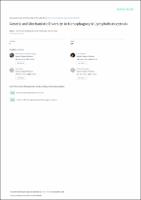| dc.contributor.author | Chinn, Ivan K. | |
| dc.contributor.author | Eckstein, Olive S. | |
| dc.contributor.author | Peckham-Gregory, Erin C. | |
| dc.contributor.author | Goldberg, Baruch R. | |
| dc.contributor.author | Forbes, Lisa R. | |
| dc.contributor.author | Nicholas, Sarah K. | |
| dc.contributor.author | Mace, Emily M. | |
| dc.contributor.author | Vogel, Tiphanie P. | |
| dc.contributor.author | Abhyankar, Harshal A. | |
| dc.contributor.author | Díaz, María I. | |
| dc.contributor.author | Heslop, Helen E. | |
| dc.contributor.author | Krance, Robert A. | |
| dc.contributor.author | Martinez, Caridad A. | |
| dc.contributor.author | Aldave Becerra, Juan Carlos | |
| dc.date.accessioned | 2021-11-03T14:07:44Z | |
| dc.date.available | 2021-11-03T14:07:44Z | |
| dc.date.issued | 2018-07 | |
| dc.identifier.citation | Blood. 2018; 132(1) | es_PE |
| dc.identifier.uri | https://hdl.handle.net/20.500.12959/1980 | |
| dc.description.abstract | Los criterios HLH-2004 se utilizan para diagnosticar la linfohistiocitosis hemofagocítica (HLH), pero existe preocupación por su aplicación incorrecta, lo que resulta en un tratamiento subóptimo de algunos pacientes. Buscamos definir el espectro genómico y los resultados asociados de una cohorte diversa de niños que cumplían con los criterios HLH-2004. Las pruebas genéticas se realizaron clínicamente o mediante la secuenciación del exoma completo basada en la investigación. Se analizaron las métricas clínicas con respecto a los resultados genómicos. De 122 sujetos inscritos en el transcurso de 17 años, 101 sujetos recibieron pruebas genéticas. Los defectos del gen HLH familiar bialélico (fHLH) se identificaron solo en 19 (19%) y se correlacionaron con la presentación a menos de 1 año de edad ( P<0,0001). Se observaron variantes de fHLH digénicas, pero carecían de apoyo estadístico para la asociación de enfermedades. En 28 (58%) de 48 sujetos, los análisis de secuenciación del exoma completo de la investigación identificaron con éxito las posibles explicaciones moleculares, incluidas las enfermedades de inmunodeficiencia primaria subyacentes, la activación inmunitaria desregulada y los trastornos de proliferación, y afecciones genéticas potencialmente nuevas. Dos tercios de los pacientes identificados por los criterios HLH-2004 tenían etiologías subyacentes para HLH, incluidos defectos genéticos, autoinmunidad y malignidad. La supervivencia global fue del 45% y el aumento de la mortalidad se correlacionó con la HLH desencadenada por una infección o una neoplasia maligna ( P<0,05). Las diferencias en la supervivencia no se correlacionaron con el perfil genético o la extensión de la terapia. La HLH debe conceptualizarse como un fenotipo de enfermedad crítica caracterizada por la activación tóxica de las células inmunes a partir de diferentes mecanismos subyacentes. En la mayoría de los pacientes con HLH, la secuenciación dirigida de los genes fHLH sigue siendo insuficiente para identificar los mecanismos patogénicos. Sin embargo, la secuenciación del exoma completo puede identificar oportunidades terapéuticas específicas y afectar las opciones de trasplante de células madre hematopoyéticas para estos pacientes. | es_PE |
| dc.description.abstract | The HLH-2004 criteria are used to diagnose hemophagocytic lymphohistiocytosis (HLH),
yet concern exists for their misapplication, resulting in suboptimal treatment of some
patients. We sought to define the genomic spectrum and associated outcomes of a diverse
cohort of children who met the HLH-2004 criteria. Genetic testing was performed clinically
or through research-based whole-exome sequencing. Clinical metrics were analyzed with
respect to genomic results. Of 122 subjects enrolled over the course of 17 years, 101
subjects received genetic testing. Biallelic familial HLH (fHLH) gene defects were identified
in only 19 (19%) and correlated with presentation at younger than 1 year of age (P < .0001).
Digenic fHLH variants were observed but lacked statistical support for disease association.
In 28 (58%) of 48 subjects, research whole-exome sequencing analyses successfully
identified likely molecular explanations, including underlying primary immunodeficiency
diseases, dysregulated immune activation and proliferation disorders, and potentially
novel genetic conditions. Two-thirds of patients identified by the HLH-2004 criteria had
underlying etiologies for HLH, including genetic defects, autoimmunity, and malignancy.
Overall survival was 45%, and increased mortality correlated with HLH triggered by infection or malignancy (P < .05). Differences in survival did not correlate with genetic profile or extent of therapy. HLH
should be conceptualized as a phenotype of critical illness characterized by toxic activation of immune cells from
different underlying mechanisms. In most patients with HLH, targeted sequencing of fHLH genes remains insufficient
for identifying pathogenic mechanisms. Whole-exome sequencing, however, may identify specific therapeutic opportunities and affect hematopoietic stem cell transplantation options for these patients. | |
| dc.format | application/pdf | es_PE |
| dc.language.iso | eng | es_PE |
| dc.publisher | American Society of Hematology | es_PE |
| dc.relation.uri | https://ashpublications.org/blood/article/132/1/89/39281/Genetic-and-mechanistic-diversity-in-pediatric | |
| dc.rights | info:eu-repo/semantics/openAccess | es_PE |
| dc.rights.uri | https://creativecommons.org/licenses/by/4.0/ | es_PE |
| dc.subject | Genoma humano | es_PE |
| dc.subject | Linfohistiocitosis, hemofagocítica | es_PE |
| dc.subject | Estudio de asociación del genoma completo | es_PE |
| dc.subject | Linfohistiocitosis, hemofagocítica | es_PE |
| dc.subject | Prueba genética | es_PE |
| dc.subject | Secuenciación de nucleótidos de alto rendimiento | es_PE |
| dc.subject | Immunobiology and Immunotherapy | |
| dc.subject | Pediatric Hematology | |
| dc.subject | Phagocytes | |
| dc.subject | Phagocytes | |
| dc.subject | Granulocytes | |
| dc.subject | Myelopoiesis | |
| dc.title | Genetic and mechanistic diversity in pediatric hemophagocytic lymphohistiocytosis | es_PE |
| dc.type | info:eu-repo/semantics/article | es_PE |
| dc.subject.ocde | https://purl.org/pe-repo/ocde/ford#3.02.02 | es_PE |
| dc.publisher.country | PE | es_PE |
| dc.identifier.doi | https://doi.org/10.1182/blood-2017-11-814244 | |






